headlamp JAGUAR XJ6 1994 2.G User Guide
[x] Cancel search | Manufacturer: JAGUAR, Model Year: 1994, Model line: XJ6, Model: JAGUAR XJ6 1994 2.GPages: 521, PDF Size: 17.35 MB
Page 398 of 521

0
Engine Bay Fuse Box - right-hand side
Fuse No. Fuse Colour Code
- F1
F2 Red
F3
F4 Red
F5 Red
-
F6 Tan
F7 Clear
F8 Red
F9 -
FIO Tan
F12 Red
F13 Red
F14 Red F15
-
F16 Red
F17 Light Green
F18 Red
Value
(amps)
10
10
10
5
25
10
-
5
20
10
10
10
10
30
10
Circuit
Not used
Main beam headlamp
- right-hand side
Not used
Lowered beam
headlamD - riaht-hand side ."
Side light -front right-hand side
Turn indicator
-front right-hand side
Side repeater flasher
- right-hand side
Engine control module
(ECM)
Air pump (6 cyl. - where fitted)
Ignition coils
(VIZ)
Air conditioning clutch
Not used
Generator
Front lighting control module
- right-hand
Air conditioning clutch
Windshield wash
J headlamp power wash heaters and relays
Engine management system relay supply
Injectors
Engine management system
Starter relay Ignition coil sensing and air pump relay (6
cyl.)
Fuel injection relay
Engine management sensing
(VIZ)
Windshield washer pump
Lambda heaters
Idle speed control valve
Not used
Air pump control
Solenoid vacuum valve
(VIZ)
Water pump (supercharged)
Headlamp power wash pump
Front fog lamp
- right-hand side (where fitted)
0
0
Issue 1 August 1994 X300 VSM AI-95MY 15
Page 400 of 521
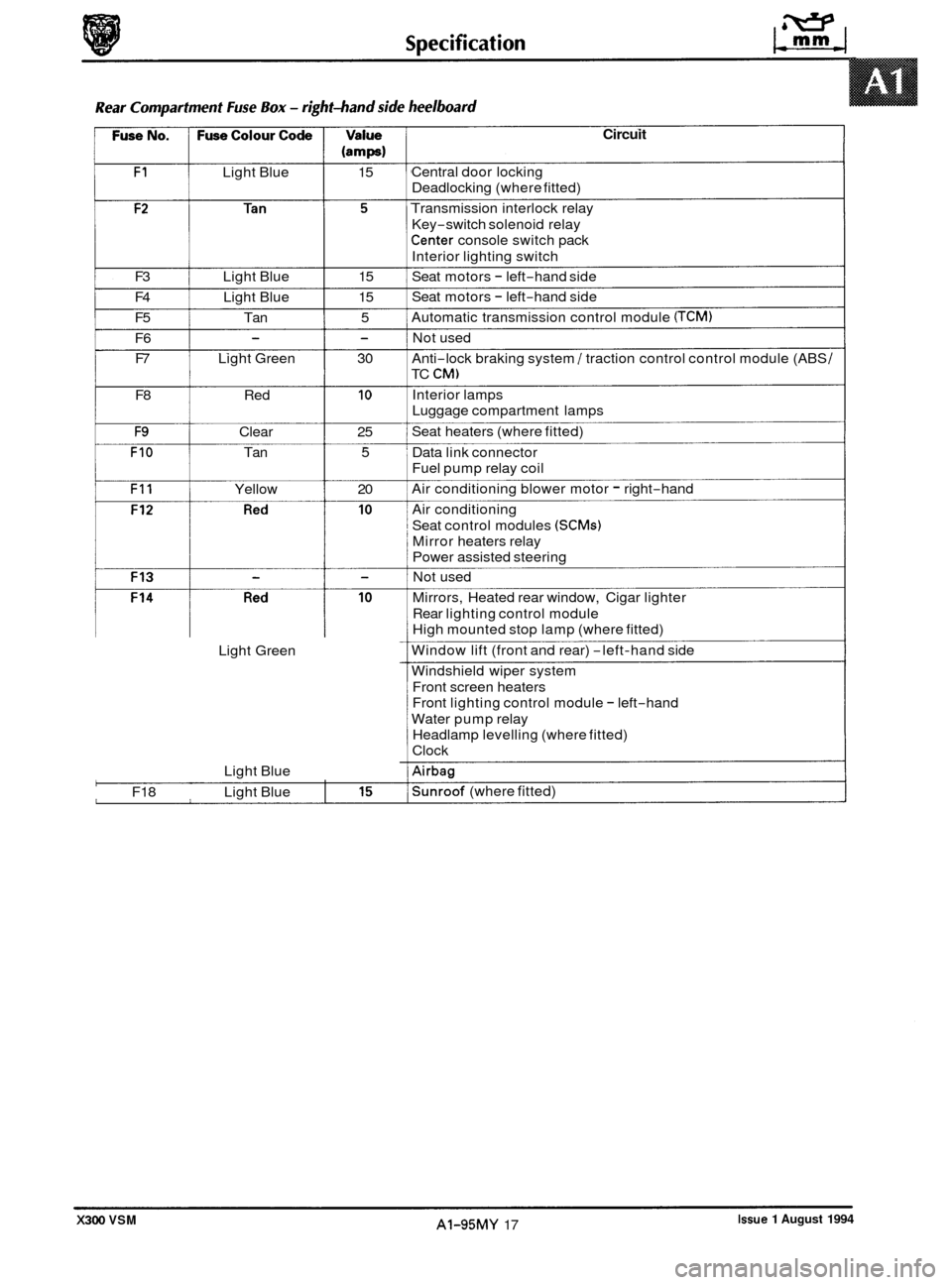
(amps)
F1 Light Blue 15
F3 Light Blue 15
F4 Light Blue 15
F5 Tan 5
F6 F7 Light Green 30
- -
F8 Red 10
F9 Clear 25
FIO Tan 5
F11 Yellow 20 0
Light Green
Light Blue
F18 Light Blue
0'
I
Circuit
Central door locking
Deadlocking (where fitted)
Transmission interlock relay
Key
-switch solenoid relay
Center console switch pack
Interior lighting switch
Seat motors
- left-hand side
Seat motors
- left-hand side
Automatic transmission control module
(TCM)
Not used
Anti
-lock braking system / traction control control module (ABS /
TC CM)
Interior lamps
Luggage compartment lamps
Seat heaters (where fitted)
Data link connector
Fuel pump relay coil
Air conditioning blower motor
- right-hand
Air conditioning
Seat control modules
(SCMs)
Mirror heaters relay
Power assisted steering
Not used
Mirrors, Heated rear window, Cigar lighter
Rear lighting control module
High mounted stop lamp (where fitted)
Window lift (front and rear)
-left-hand side
Windshield wiper system Front screen heaters
Front lighting control module
- left-hand
Water pump relay
Headlamp levelling (where fitted)
Clock
Airbag
Sunroof (where fitted)
Issue 1 August 1994 AI-95MY 17 X300 VSM
Page 459 of 521
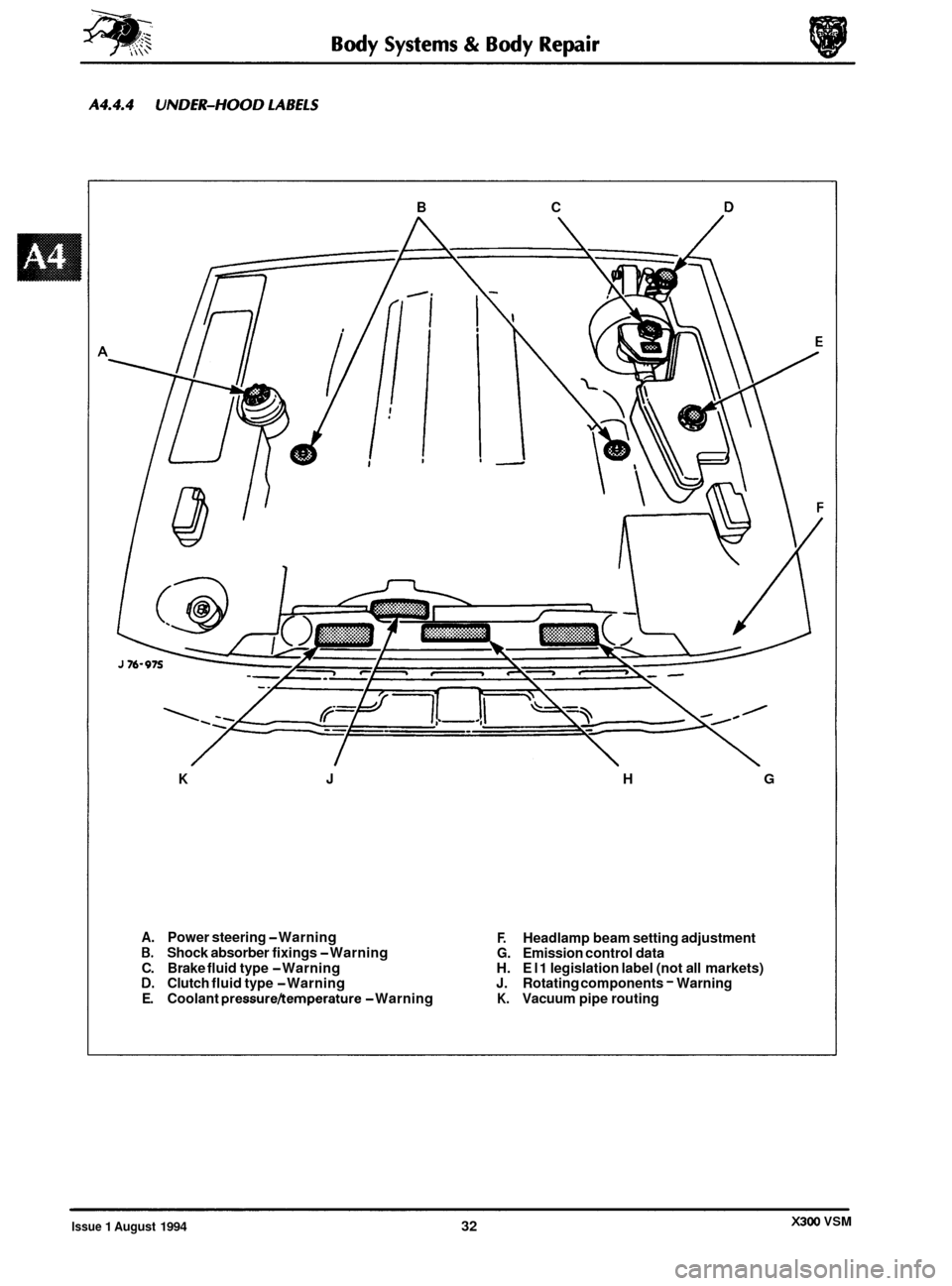
B C D
K J H G
A. Power steering -Warning F. Headlamp beam setting adjustment B. Shock absorber fixings -Warning G. Emission control data
C. Brake fluid type -Warning H. El 1 legislation label (not all markets) D. Clutch fluid type -Warning J. Rotating components - Warning
E. Coolant pressureltemperature -Warning K. Vacuum pipe routing
0
0
X300 VSM Issue 1 August 1994 32
Page 464 of 521
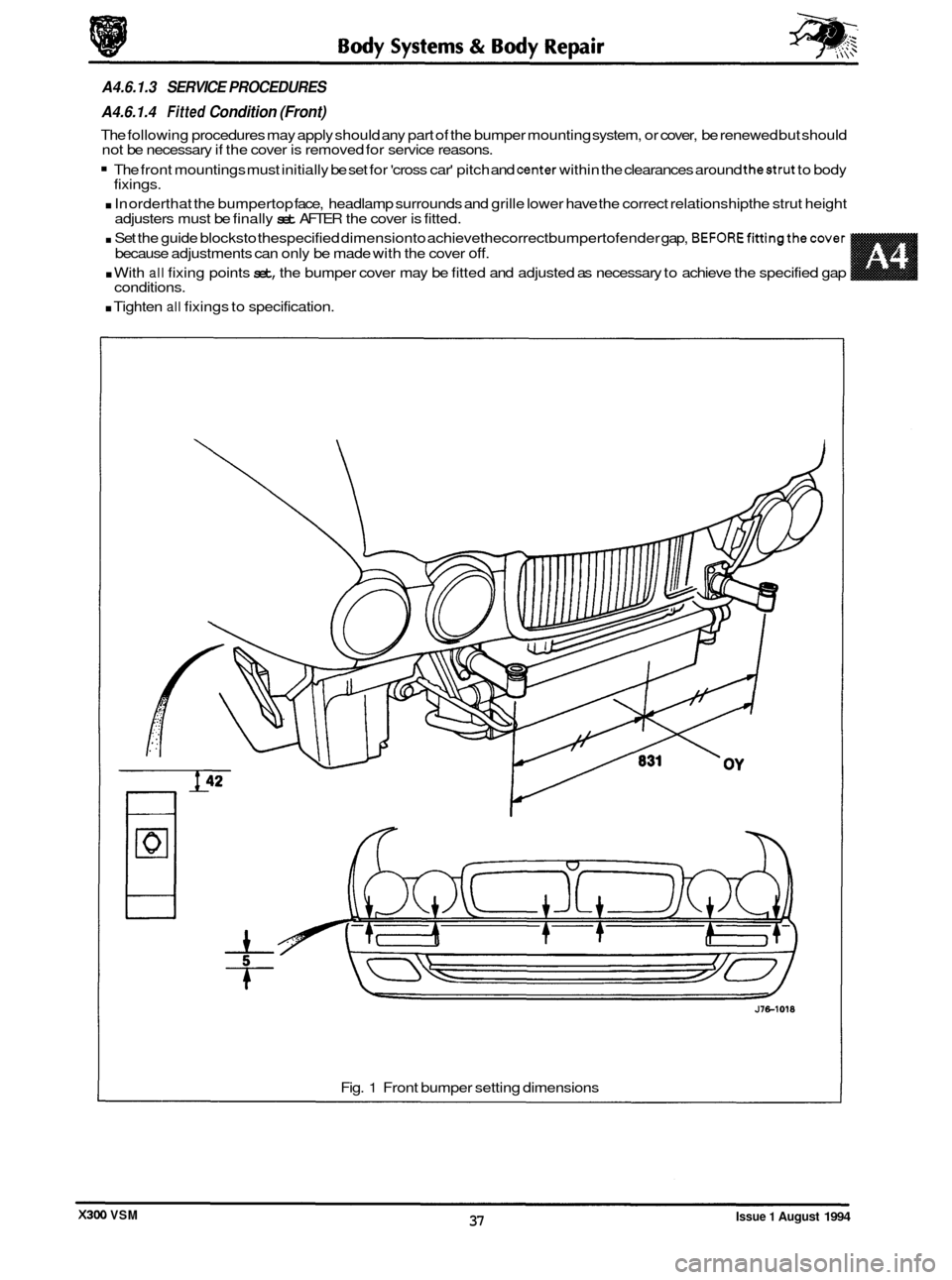
conditions.
. Tighten all fixings to specification.
A4.6.1.3 SERVICE PROCEDURES
A4.6.1.4
Fitted Condition (Front)
The following procedures may apply should any part of the bumper mounting system, or cover, be renewed but should
not be necessary if the cover is removed for service reasons.
The front mountings must initially be set for 'cross car' pitch and center within the clearances around thestrut to body
. In orderthat the bumpertop face, headlamp surrounds and grille lower have the correct relationship the strut height
. Set the guide blocksto thespecified dimensionto achievethecorrect bumpertofender gap, BEFOREfittingthecover
. With all fixing points set, the bumper cover may be fitted and adjusted as necessary to achieve the specified gap
fixings.
adjusters must be finally
set AFTER the cover is fitted.
because adjustments can only be made with the cover
off.
Fig. 1 Front bumper setting dimensions
Issue 1 August 1994 37 X300 VSM
Page 470 of 521
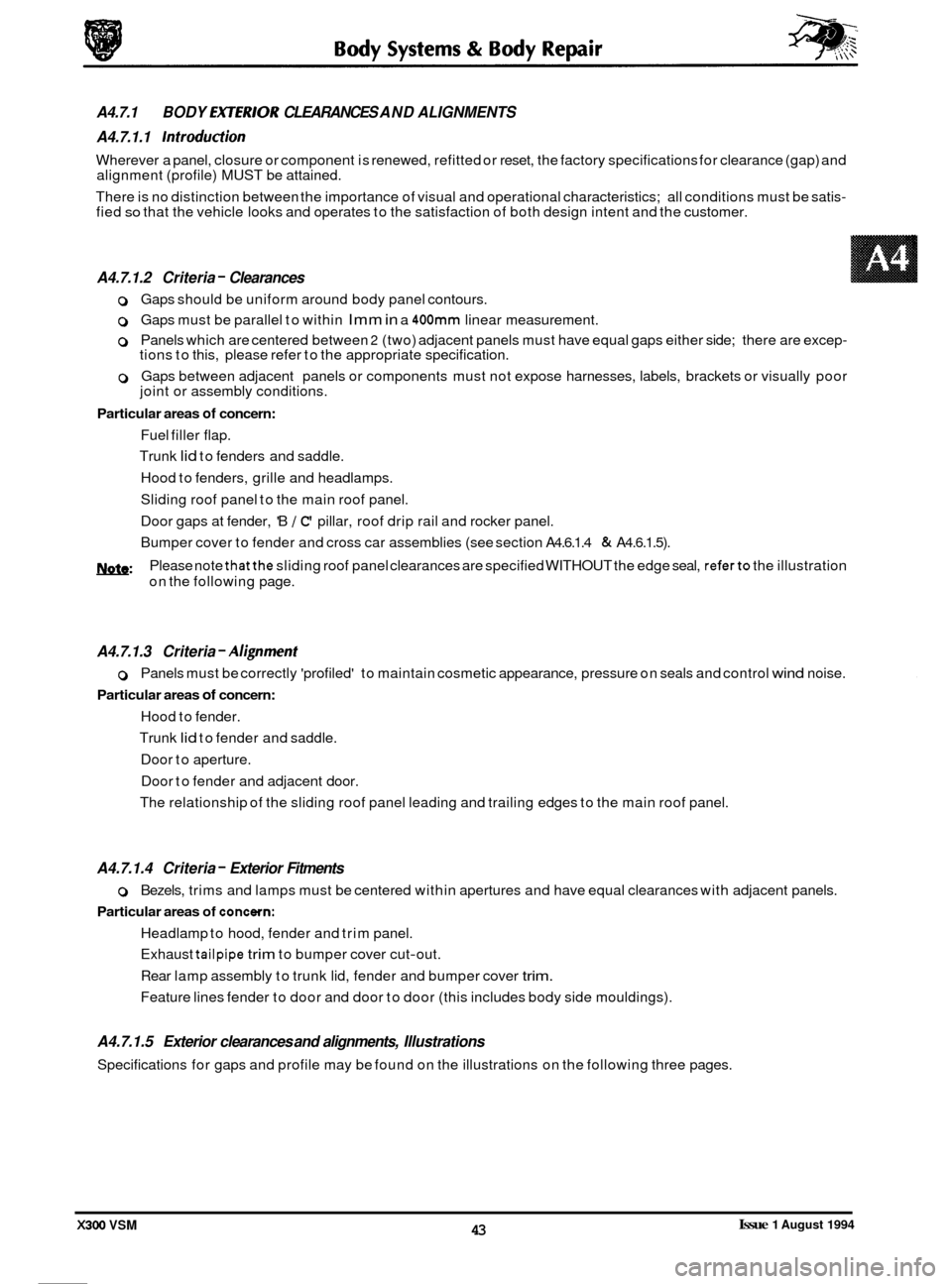
0 Gaps should be uniform around body panel contours.
0 Gaps must be parallel to within Imm in a 400mm linear measurement.
0 Panels which are centered between 2 (two) adjacent panels must have equal gaps either side; there are excep- tions to this, please refer to the appropriate specification.
0 Gaps between adjacent panels or components must not expose harnesses, labels, brackets or visually poor
joint or assembly conditions.
Particular areas of concern:
Fuel filler flap.
Trunk
lid to fenders and saddle.
Hood to fenders, grille and headlamps.
Sliding roof panel to the main roof panel.
Door gaps at fender, 'B
/ C' pillar, roof drip rail and rocker panel.
Bumper cover to fender and cross car assemblies (see section A4.6.1.4
& A4.6.1.5).
m: Please note thatthe sliding roof panel clearances are specified WITHOUT the edge seal, referto the illustration
on the following page.
A4.7.1.3 Criteria - A1;gnment
0 Panels must be correctly 'profiled' to maintain cosmetic appearance, pressure on seals and control wind noise.
Particular areas of concern:
Hood to fender.
Trunk
lid to fender and saddle.
Door to aperture.
Door to fender and adjacent door.
The relationship of the sliding roof panel leading and trailing edges to the main roof panel.
A4.7.1.4 Criteria - Exterior Fitments
Particular areas of concewn:
0 Bezels, trims and lamps must be centered within apertures and have equal clearances with adjacent panels.
Headlamp to hood, fender and trim panel.
Exhaust
tailpipe trim to bumper cover cut-out.
Rear lamp assembly to trunk lid, fender and bumper cover
trim.
Feature lines fender to door and door to door (this includes body side mouldings).
A4.7.1.5 Exterior clearances and alignments, Illustrations
Specifications for gaps and profile may be found on the illustrations on the following three pages.
A4.7.1
A4.7.1.1
Introduction
Wherever a panel, closure or component is renewed, refitted or reset, the factory specifications for clearance (gap) and
alignment (profile) MUST be attained.
There is no distinction between the importance of visual and operational characteristics; all conditions must be satis
- fied so that the vehicle looks and operates to the satisfaction of both design intent and the customer.
BODY EX7ERlOR CLEARANCES AND ALIGNMENTS
A4.7.1.2 Criteria
- Clearances
Issue 1 August 1994 43 X300 VSM
Page 478 of 521
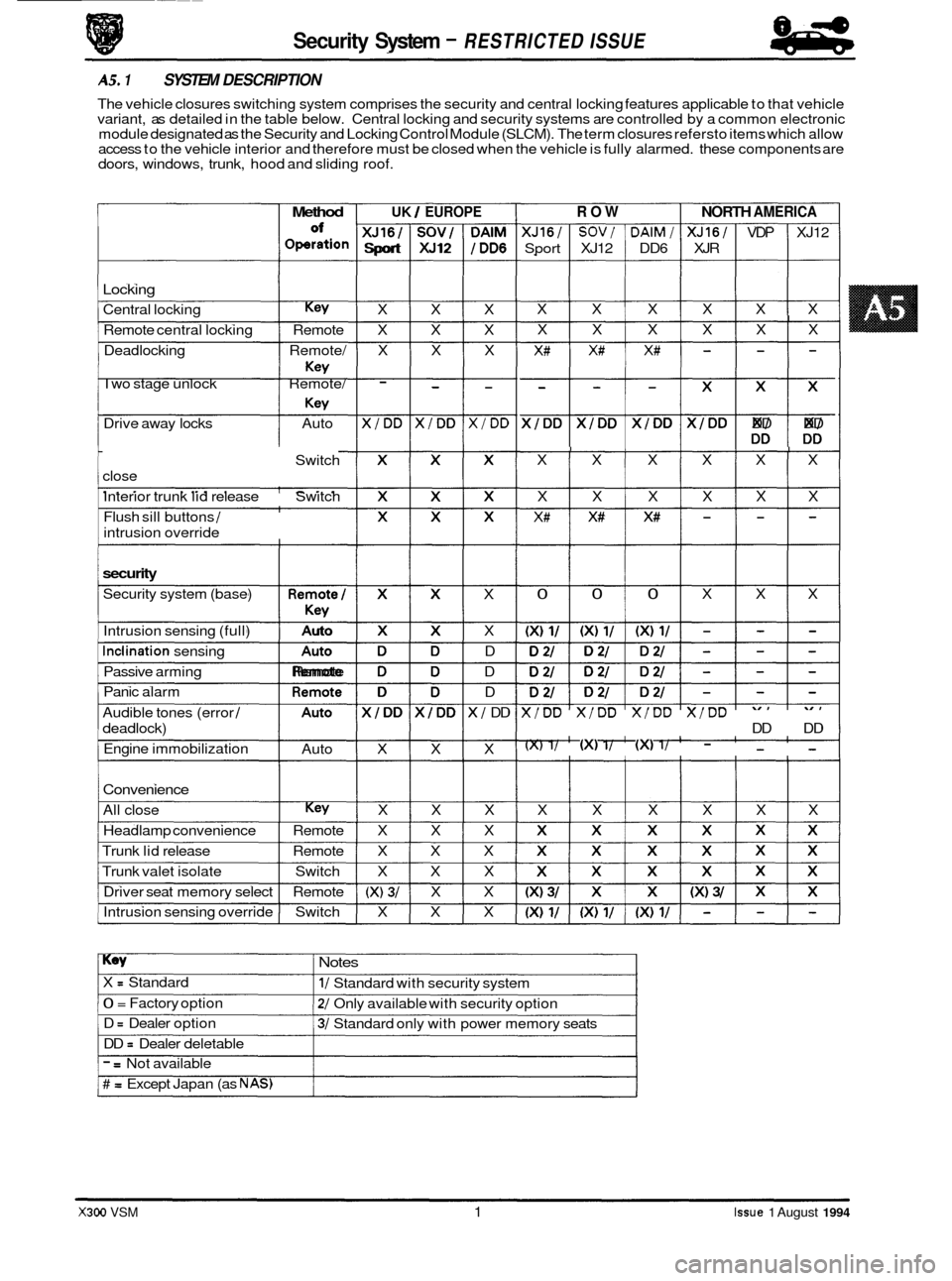
0
c
doors, windows, trunk, hood and sliding roof.
I Method I UK / EUROPE
of IXJ16I1SOVIIDAIM
Operation Sport XJ12 /DD6
Locking
Central locking Key X X X
Remote central locking Remote X X X
Deadlocking Remote/ X X X
Two stage unlock Remote/
- - - Key
Key
Drive away locks Auto X/DD X/DD X/DD
Switch
close
Interior trunk lid release Switch
Flush
sill buttons /
intrusion override
security
Security system (base)
Intrusion sensing (full)
Inclination sensing
Passive arming
Panic alarm
Audible tones (error
/
deadlock)
Engine immobilization
*
Auto
.,,,
Remote
Auto
1 XI X X
X D
D D
X/ DD
X
-~~
Security System - RESTRICTED ISSUE
AS. 1 SYSTEM DESCRIPTION
The vehicle closures switching system comprises the security and central locking features applicable to that vehicle
variant, as detailed in the table below. Central locking and security systems are controlled by a common electronic
module designated as the Security and Locking Control Module (SLCM). The term closures refersto items which allow
access to the vehicle interior and therefore must be closed when the vehicle is fully alarmed. these components are
Convenience
All close Key X X X
Headlamp convenience Remote X X X
Trunk lid release Remote X X X
Trunk valet isolate Switch X X X
Driver seat memory select Remote
(X) 3/ X X
Intrusion sensing override Switch X X X
ROW NORTH AMERICA
XJ16/ SOV/ DAlM/ XJ16/ VDP XJ12
Sport XJ12 DD6 XJR
X X X X X X
I X X X X X X
X# X# X# - - -
$$$$$ DD DD
I I I I I X X X X X X
X X X X X X
X# X# X# - - -
I 0 0 0 X X X
X/DD X/DD X/DD X/DD
DD DD
(X) 1/ (XI 1/ (XI 1/ - - -
X X X X X X
Key Notes
X = Standard
0 = Factory option
D
= Dealer option
DD
= Dealer deletable
1/ Standard with security system
2/ Only available with security option
3/ Standard only with power memory seats
- = Not available
# = Except Japan (as NAS)
X300 VSM 1 Issue 1 August 1994
Page 485 of 521
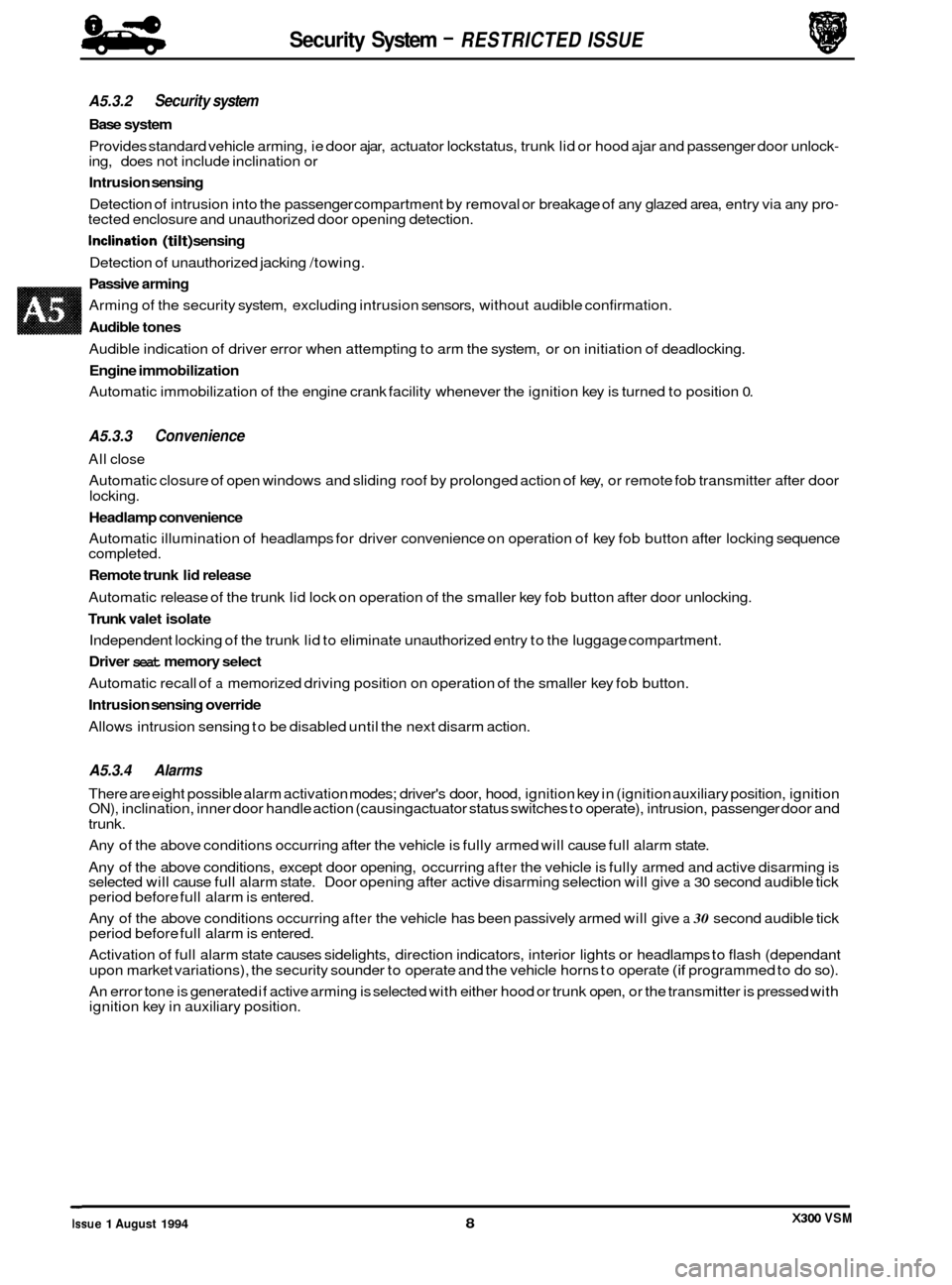
Security System - RESTRICTED ISSUE 8-8
-
A5.3.2 Security system
Base system
Provides standard vehicle arming, ie door ajar, actuator lockstatus, trunk lid or hood ajar and passenger door unlock- ing, does not include inclination or
Intrusion sensing
Detection of intrusion into the passenger compartment by removal or breakage of any glazed area, entry via any pro- tected enclosure and unauthorized door opening detection.
Inclination (tilt) sensing
Detection of unauthorized jacking /towing.
Passive arming
Arming of the security system, excluding intrusion sensors, without audible confirmation.
Audible tones
Audible indication of driver error when attempting to arm the system, or on initiation of deadlocking.
Engine immobilization
Automatic immobilization of the engine crank facility whenever the ignition key is turned to position 0.
A5.3.3 Convenience
All close
Automatic closure of open windows and sliding roof by prolonged action of key, or remote fob transmitter after door
locking.
Headlamp convenience
Automatic illumination of headlamps for driver convenience on operation of key fob button after locking sequence
completed.
Remote trunk lid release
Automatic release of the trunk lid lock on operation of the smaller key fob button after door unlocking.
Trunk valet isolate
Independent locking of the trunk lid to eliminate unauthorized entry to the luggage compartment.
Driver seat memory select
Automatic recall of a memorized driving position on operation of the smaller key fob button.
Intrusion sensing override
Allows intrusion sensing to be disabled until the next disarm action.
A5.3.4 Alarms
There are eight possible alarm activation modes; driver's door, hood, ignition key in (ignition auxiliary position, ignition ON), inclination, inner door handle action (causing actuator status switches to operate), intrusion, passenger door and
trunk.
Any of the above conditions occurring after the vehicle is fully armed will cause full alarm state.
Any of the above conditions, except door opening, occurring
after the vehicle is fully armed and active disarming is
selected will cause full alarm state. Door opening after active disarming selection will give a 30 second audible tick
period before full alarm is entered.
Any of the above conditions occurring
after the vehicle has been passively armed will give a 30 second audible tick
period before full alarm is entered.
Activation of full alarm state causes sidelights, direction indicators, interior lights or headlamps to flash (dependant
upon market variations), the security sounder to operate and the vehicle horns to operate
(if programmed to do so).
An error tone is generated if active arming is selected with either hood or trunk open, or the transmitter is pressed with
ignition key in auxiliary position.
0
X300 VSM Issue 1 August 1994 8
Page 486 of 521
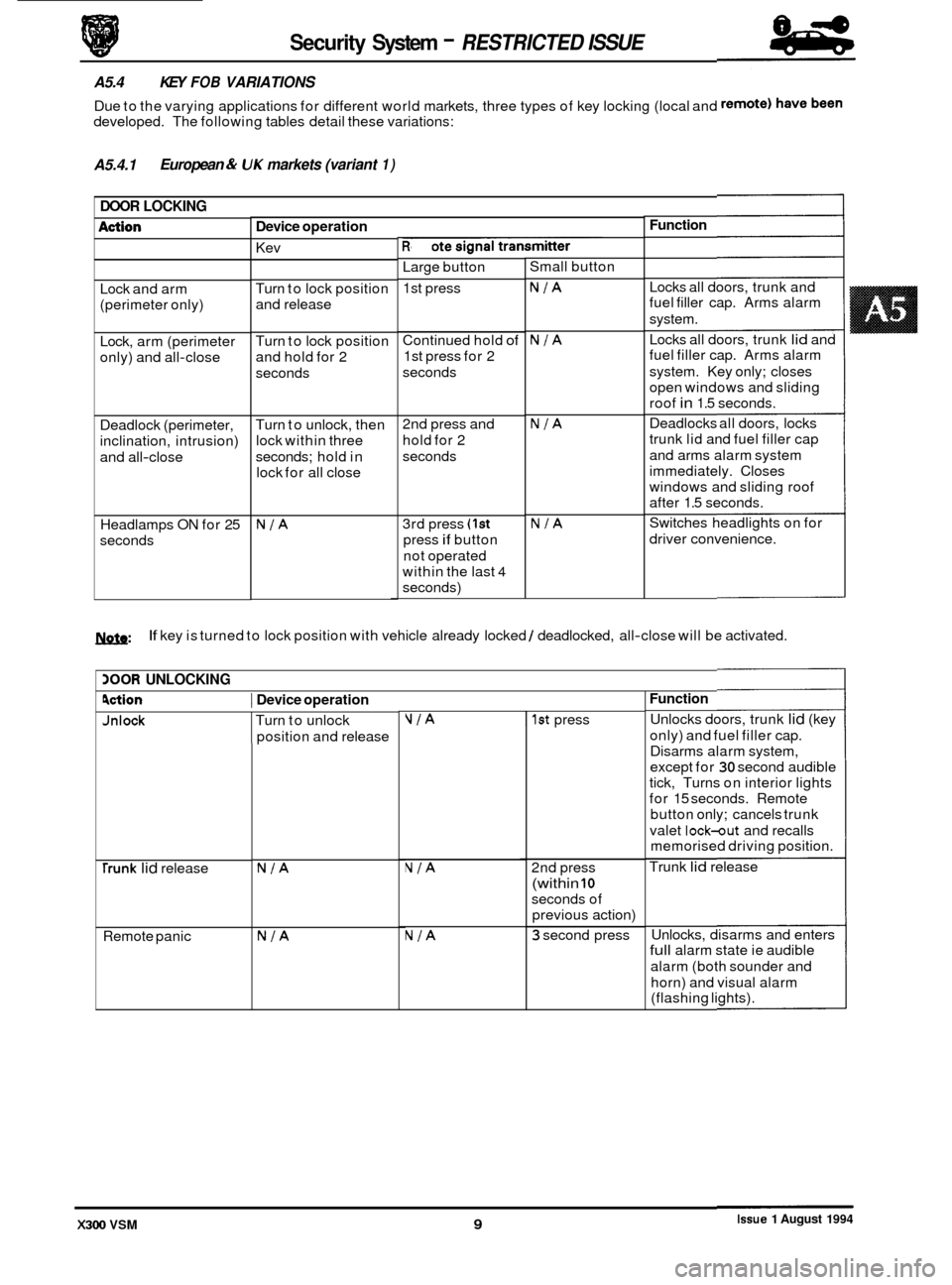
Jnlock Turn to unlock
position and release VIA I 1st press
Security System - RESTRICTED ISSUE
A5.4 KEY FOB VARIATIONS
Due to the varying applications for different world markets, three types of key locking (local and
developed. The following tables detail these variations:
A5.4.1 European & UK markets
(variant 1)
DOOR LOCKING
Function
Device operation
Remote signal transmitter
Kev -
Large button
1st press Small
button
Locks all doors, trunk and
fuel filler cap. Arms alarm
system.
Locks all doors, trunk
lid and
fuel filler cap. Arms alarm
system. Key only; closes
open windows and sliding
roof
in 1.5 seconds.
Deadlocks all doors, locks
trunk lid and fuel filler cap
and arms alarm system
immediately. Closes
windows and sliding roof
after 1.5 seconds.
Switches headlights on for
driver convenience.
Lock
and arm
(perimeter only)
NIA Turn to lock position
and release
Continued hold
of
1st press for 2
seconds NIA
NIA
Lock, arm (perimeter
only) and all
-close Turn
to lock position
and hold for 2
seconds
Deadlock (perimeter,
inclination, intrusion)
and all
-close Turn
to unlock, then
lock within three
seconds; hold in
lock for all close 2nd
press and
hold for 2
seconds
0
Headlamps ON for 25
seconds 3rd
press (1st
press if button
not operated
within the last
4
seconds)
NIA NIA
1ynfn: If key is turned to lock position with vehicle already locked / deadlocked, all-close will be activated.
BOOR UNLOCKING
Function
Unlocks doors, trunk lid (key
only) and fuel filler cap.
Disarms alarm system,
except for
30 second audible
tick, Turns on interior lights
for 15 seconds. Remote
button only; cancels trunk
valet
lock-out and recalls
memorised driving position.
Trunk
lid release
9ction I Device operation
0
0
NIA 2nd press
(within 10
seconds of
previous action)
NIA
NIA
rrunk lid release
Remote panic
NIA 3 second press Unlocks,
disarms and enters full alarm state ie audible
alarm (both sounder and
horn) and visual alarm
(flashing lights).
Issue 1 August 1994 X300 VSM 9
Page 487 of 521
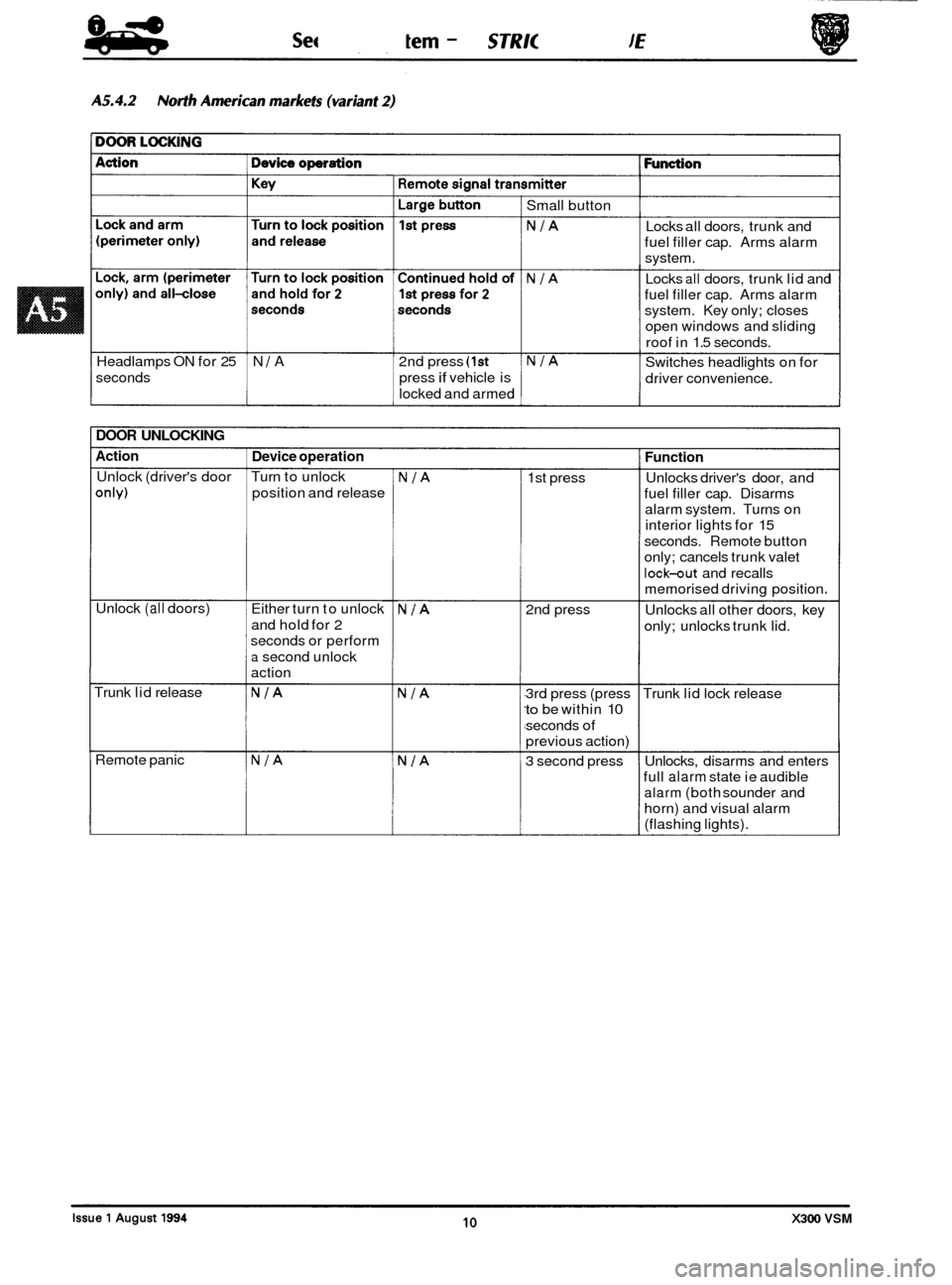
Security System - RESTRICTED ISSUE
Headlamps ON for 25 N 1 A 2nd press (1st
seconds press if vehicle is
locked and armed Small
button
NIA Locks all doors, trunk and
fuel filler cap. Arms alarm
system.
Locks
all doors, trunk lid and
fuel filler cap. Arms alarm
system. Key only; closes
open windows and sliding
roof in 1.5 seconds.
NIA Switches headlights on for
driver convenience.
NIA
DOOR UNLOCKING
Action
Unlock (driver's door
only)
Unlock (all doors)
Trunk lid release
Remote panic
Device operation
Turn to unlock
position and release
Either turn to unlock
and hold for 2
seconds or perform
a second unlock
action
NIA
NIA
NIA
NIA
NIA
NIA
1st press
2nd press
3rd press (press
to be within 10
seconds of
previous action)
3 second press
Function
Unlocks driver's door, and
fuel filler cap. Disarms
alarm system. Turns on
interior lights for 15
seconds. Remote button
only; cancels trunk valet
lock-out and recalls
memorised driving position.
Unlocks all other doors, key
only; unlocks trunk lid.
Trunk lid lock release
Unlocks, disarms and enters
full
alarm state ie audible
alarm (both sounder and
horn) and visual alarm
(flashing lights).
10 X300 VSM
Page 490 of 521
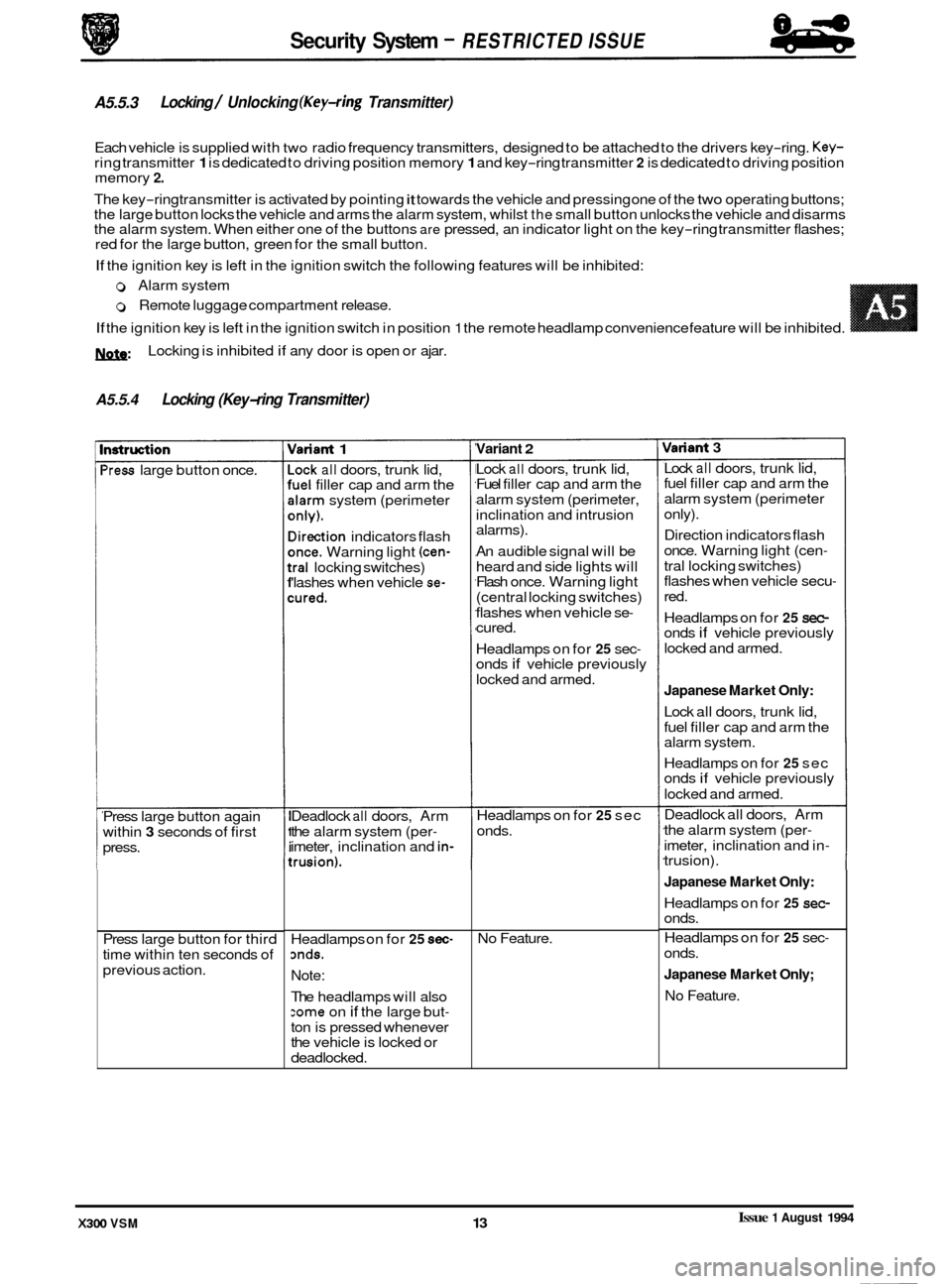
w:
A5.5.4 Locking (Key-ring Transmitter)
Locking is inhibited if any door is open or ajar.
nstruction
'ress large button once.
Press large button again
within
3 seconds of first
press.
Press large button for third
time within ten seconds of
previous action.
rlariant 1
-ock all doors, trunk lid, 'uel filler cap and arm the
darm system (perimeter
mly).
lirection indicators flash
mce. Warning light (cen-
:ral locking switches)
'lashes when vehicle se-
:ured.
Deadlock all doors, Arm
the alarm system (per
- imeter, inclination and in-
:rusion).
Variant 2
Security System - RESTRICTED ISSUE
A5.5.3
Each vehicle is supplied with two radio frequency transmitters, designed to be attached to the drivers key-ring. Key- ring transmitter 1 is dedicated to driving position memory 1 and key-ring transmitter 2 is dedicated to driving position
memory 2.
The key-ring transmitter is activated by pointing it towards the vehicle and pressing one of the two operating buttons;
the large button locks the vehicle and arms the alarm system, whilst the small button unlocks the vehicle and disarms
the alarm system. When either one of the buttons are pressed, an indicator light on the key-ring transmitter flashes;
red for the large button, green for the small button.
If the ignition key is left in the ignition switch the following features will be inhibited:
Locking / Unlocking (Key-ring Transmitter)
0 Alarm system
0 Remote luggage compartment release.
If the ignition key is left in the ignition switch in position 1 the remote headlamp convenience feature will be inhibited. ~~ ~
Headlamps on for 25 sec- mds.
Note:
The headlamps will also :ome on if the large but-
ton is pressed whenever
the vehicle is locked or
deadlocked. Lock
all doors,
trunk lid,
Fuel filler cap and arm the
alarm system (perimeter,
inclination and intrusion
alarms).
An audible signal will be
heard and side lights will
Flash once. Warning light
(central locking switches)
flashes when vehicle se
- cured.
Headlamps on for
25 sec- onds if vehicle previously
locked and armed.
Headlamps on for
25 sec
onds.
No Feature.
Variant 3
Lock all doors, trunk lid,
fuel filler cap and arm the
alarm system (perimeter
only).
Direction indicators flash
once. Warning light (cen
-
tral locking switches)
flashes when vehicle secu-
red.
Headlamps on for
25 sec- onds if vehicle previously
locked and armed.
Japanese Market Only:
Lock all doors, trunk lid,
fuel filler cap and arm the
alarm system.
Headlamps on for
25 sec
onds if vehicle previously
locked and armed.
Deadlock all doors, Arm
the alarm system (per
-
imeter, inclination and in- trusion).
Japanese Market Only:
Headlamps on for 25 sec- onds.
Headlamps on for
25 sec-
onds.
Japanese Market Only;
No Feature.
Issue 1 August 1994 X300 VSM 13